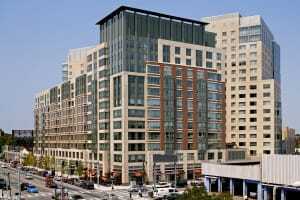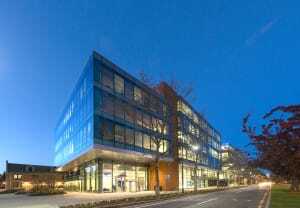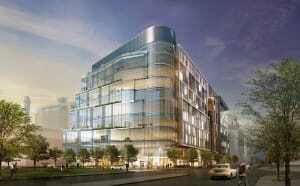Recovery is still on across the Northeast, including Connecticut, Massachusetts, New Jersey, New York, and Pennsylvania.
Expansion in the life sciences and technology sectors, as well as increased transit-oriented development (TOD), is spurring real estate in Boston.
Neighboring Connecticut is reporting improved job creation that is driving a vigorous multifamily sector and a new wave of renovations.
New York City is seeing strong growth in waterfront development in addition to a robust hospitality industry.
In Pennsylvania, Philadelphia is experiencing an unparalleled spike in outside investment, whereas in Pittsburgh, downtown residential, hospitality, and mixed-use projects are strong.
And a growing residential base in northern New Jersey, particularly in Jersey City, and Hoboken and its surrounding neighborhoods, is contributing to steady construction in the shadow of the Big Apple.
The Northeast region of the United States—Massachusetts, Connecticut, New York, Pennsylvania, and New Jersey—is undergoing renewed real estate activity thanks to rising investment from outside the United States, pent-up demand for new product, and new business activity by budding entrepreneurs.
New York City continues to attract foreign investment, as do other East Coast cities, including Boston and Philadelphia, says Joseph Aliotta, principal and studio leader in the New York office of the Perkins Eastman planning, design, and consulting firm. “Investors perceive New York and major northeastern cities as a stable place to put their money,” he says. “We’re seeing a lot of investment coming here from China, Europe, and Russia.”
Massachusetts
Rising investment from numerous outside sources is propelling strong demand in the Boston area for smartly developed, well-positioned properties, says Steve Thomas, executive vice president and director of the real estate practice at VHB, a Boston-based transportation, land use, and environmental firm. “This portends a strong development market for the next 18 to 24 months,” he says.
Transportation resources are key to the location of new development and investment. “The transit corridors are now becoming the urban investment corridors,” Thomas says. “Employers want access to multiple labor pools, so they locate operations in these transit corridors. Companies are also responding to the evolution of the workplace and are seeking to attract and retain the best employees. Millennials demand accessibility and transit—and lots of amenities and entertainment experiences—so they are moving to the downtown areas.”
VHB is involved in a number of transit-oriented ventures in Boston, including Ink Block, National Development’s creative redevelopment in Boston’s South End neighborhood for which VHB performed permitting, site/civil engineering, and utility infrastructure design. “National Development is transforming the former Boston Herald newspaper site into a vibrant new community,” Thomas says. Ink Block will have more than 400 residential units, 85,000 square feet (7,900 sq m) of ground-floor retail space, and a 50,000-square-foot (4,600 sq m) flagship Whole Foods Market, he says. “This development is redefining an underutilized commercial zone as the new and hip part of one of Boston’s most urban neighborhoods.”
VHB also is a key member of the development team for a number of other projects, including Boston Properties & Delaware North Companies’ 1.8 million-square-foot (167,000 sq m) mixed-use venture adjacent to North Station, the second-largest commuter-rail destination in Boston. The Boston Garden development includes residential, hotel, office, and retail uses, Thomas says.
Large mixed-use development continues to dominate the Boston area, says Gregory P. Quatchak, founding principal of Pittsburgh-based Civil & Environmental Consultants (CEC).
“The redevelopment of the Boston Seaport District is a transit-oriented project anchored by the U.S. federal courthouse and the Boston Convention Center and is slated for future expansion,” he notes. CEC is involved in the redevelopment of the historic 1820 courthouse in Plymouth, scheduled to be completed in 2020 and commemorating the 400th anniversary of the Plymouth landing, he says. The building facade and original elements will be retained, and a modern city hall will be constructed on the expanded site.
Life sciences is among the sectors driving real estate activity in the Boston region, says Al Spagnolo, president and founding partner of the Boston-based architecture, interior design, and planning firm SGA. “Many higher-education institutions are advancing or contemplating a broad array of building,” he says. “New transit-oriented development projects throughout the metropolitan area are focusing on commercial, housing, and retail mixed use.”
SGA is leading design work on one of the largest developments in Cambridge’s Kendall Square—the $220 million life sciences complex at 50 + 60 Binney Street. That project, now under construction and expected to be completed in December 2016, will feature more than 500,000 square feet (47,000 sq m) of office and laboratory facilities, retail space, on-site amenities, and parking.
SGA is also involved in the 185,000-square-foot (17,000 sq m) Linx development in nearby Watertown, which involves the conversion and expansion of a former warehouse facility into a state-of-the-art, technology-focused workplace, says Spagnolo. In Somerville, the company is leading the effort to develop several high-rise commercial buildings adjacent to the new transit stop at Assembly Row, he adds.
New York
This year is expected to be another strong one for New York City, says Aliotta of Perkins Eastman. “The commercial sector is doing fine, and residential—especially high-end residential that is attracting foreign buyers—continues to do well, with tall, needle-like buildings popping up all over,” he notes.

The Old County Courthouse in Plymouth, Massachusetts, is being renovated in preparation for observance of the 400th anniversary of the Plymouth landing in 1620. When completed in 2020, the structure will become the gateway to a new town hall complex. Civil & Environmental Consultants provided pre-demolition services for the development. (Plymouth Redevelopment Authority)
Perkins Eastman is involved with a number of waterfront-related projects in the city. “We’re working on the New York Wheel on Staten Island, a 630-foot (192 m) observation wheel, the tallest in the Western Hemisphere, which officials hope will attract some of the 4 million people a year who take the Staten Island Ferry and keep them on Staten Island,” he says. “We’re also continuing our work on the Arverne by the Sea development, a mixed-use residential community with some 1,500 multifamily units in low- and mid-rise buildings in Queens. Many of the units were built prior to Superstorm Sandy, and they survived the storm really well.”
Hurricane Sandy, in fact, is changing the way some of the city’s waterfront developments are being built, says William Kenworthey, partner and urban design practice leader at the New York City architectural and urban design firm Cooper Robertson. That firm is involved with waterfront projects in Staten Island; Greenpoint, Red Hook, and Gowanus in Brooklyn; and Newark and Asbury Park, New Jersey.
“The resiliency issues raised by the impact of Sandy are driving design thinking for these developments—and the attitude that ‘we will not abandon the waterfront’ still rings true,” says Kenworthey. “How to make a waterfront experience that embraces the uniqueness of a particular place, enhances the waterfront, and protects investments from storm events and sea-level rise are the goals we work toward in our designs.”
Resilience is born of sustainability and addresses the ability to adapt to impacts of climate change, Kenworthey explains. “This adaptability will continue to be a major goal of large-scale and waterfront plans going forward if they are to create and maintain value over the long term in a changing environment,” he says. “Sustainability is a major factor in mitigation of the climate change issues presented by the international science community.”

SGA designed 50 + 60 Binney, two buildings for Alexandria Center, a more than $500 million, 1.75 million-square-foot (163,000 sq m) build-to-suit science and technology campus on 11 acres (4.5 ha) in Cambridge, Massachusetts. The development is a project of Alexandria Real Estate Equities of Pasadena, California. (sga)
Thanks to a strong economy and an increasing influx of visitors, the Big Apple’s lodging industry is enjoying robust growth, says Lawrence B. Wolfe, senior managing director at New York City–based commercial property broker Eastdil Secured. “Global investors still see New York City as a desirable destination for their capital, with the last 12 months showing record levels of investment in sales of existing properties as well as new construction of hotels,” he says.
Notable recent transactions include the $1.95 billion acquisition of the Waldorf Astoria New York by Beijing-based Anbang Insurance Group; purchase of the Baccarat Hotel for $230 million by China’s Sunshine Life; and the sale of the Sofitel New York hotel to Hong Kong–based Keck Seng Investments. “The pipeline of pending sales is also strong,” Wolfe adds. “Brooklyn is also now sharing in the prosperity with several projects under construction.”
Pennsylvania
The Philadelphia area, the largest metropolis in the Keystone State, is experiencing an upswing in investment interest in every asset class, and it is coming from a multitude of sources, including national equity investors, regional and local institutions, and operators, says Howard Grossman, a member of the real estate practice group in the Philadelphia office of the national law firm Cozen O’Connor.
“While Philadelphia has long been, for many, merely a resting point between New York and Washington, D.C., we’ve begun to see a dramatic shift in that perception as the city becomes a focus of capital investment from around the nation,” Grossman says. “The city’s development pipeline currently exceeds $8 billion.”
Philadelphia’s real estate market is seeing unprecedented growth, with major projects including the 1.2 million-square-foot (112,000 sq m) Comcast Innovation and Technology Center now under construction; ongoing expansions of Drexel, Penn, and Temple universities and their affiliated medical and research centers; construction of the new FMC Tower headquarters at Cira Centre South; and the development of the 4.3-acre (1.7 ha) East Market retail, apartment, and office project in Center City Philadelphia.
While lower prices have slowed natural gas production from the Marcellus Shale and Utica fields, the push for natural gas infrastructure and processing facilities continues to influence industrial real estate markets in southeastern Pennsylvania. Industrial space in the Lehigh Valley submarket outside Philadelphia is tight, notes Andrew Mele, a principal at Dallas-based Trammell Crow. “At present, there are currently no available vacancies over 300,000 square feet [28,000 sq m] in the entire submarket, with predictions that the space being delivered in 2015 will be efficiently absorbed due to existing pent-up demand,” he says.
In western Pennsylvania, outside investments are leading downtown Pittsburgh to see increased residential, hospitality, mixed-use, and office development. The demand for new product in the multifamily market continues to be strong, says CEC’s Quatchak. “We can’t recall any other time when so many apartment projects were in the pipeline,” he notes. “Interest in single-tenant retail, corporate office, and large industrial development projects is also gaining momentum across the state.”
CEC is involved in numerous multifamily, retail, corporate office, warehouse and distribution, and industrial developments, including the Tower at PNC Plaza in the central business district and Industrial Scientific’s corporate headquarters campus along the Parkway West area of the city.
New Jersey

A joint venture of Samuels & Associates and Boylston Properties, Fenway Triangle Trilogy in Boston’s Fenway neighborhood includes 405 luxury apartment units and 171 units owned by Harvard University. VHB provided permitting, civil engineering, and transportation planning services. Between 1999 and 2013, Samuels purchased more than 18.4 acres (7.4 ha) in the Fenway district and led the tranformation of the area into a thriving destination. (Robert Benson Photography)
The Garden State continues on an uptick. Boosting New Jersey’s economic outlook is the labor market, which saw improvement in the fourth quarter of 2014 that has continued into 2015, says Sohini Chowdhury, an economist at Moody’s Analytics of West Chester, Pennsylvania. “Employment grew by a 1.2 percent annualized rate in the 2015 first quarter, despite a soft March employment report,” she explains. “With hiring in high- and midwage jobs picking up, the job mix also turned more favorable in the 2015 first quarter.”
In New Jersey, “we are seeing stronger demand for office in close-in suburbs than more distant areas as well as good demand for warehouse properties in general,” says Marty Reid, interim chief executive officer and president of Princeton-based Chambers Street Properties, a real estate investment trust focused on industrial and office properties.
Reid notes that office properties in Jersey City are benefiting from strong absorption in lower Manhattan (with which it competes), state tax incentives, a lower cost structure than New York City, and extremely convenient transportation infrastructure, with Port Authority Trans-Hudson (PATH) rapid rail and ferry access to the city. “We are seeing increased tenant demand as a result,” says Reid. “The residential and amenity base in Hoboken and the surrounding area is also growing. We do not see the same level of demand in the suburbs further away from NYC.”
New Jersey’s dense population powers a major economy by itself, Reid adds, further fueling demand for industrial facilities supported by transportation infrastructure. “We see bulk distribution benefiting from the national trends of increasing e-commerce and believe the East Coast ports will benefit with the Panama Canal expansion and from labor issues that have occurred with West Coast ports,” Reid says.
Connecticut

The District Burlington, National Development’s 1.5 million-square-foot (139,000 sq m) mixed-use venture in Burlington, Massachusetts, includes an office complex, a 170-room hotel, restaurants, and retail space. VHB provided survey, civil/site engineering, traffic engineering, permitting, and environmental services for the project. (National Development)
While not reporting as robust an economic outlook as its neighbors, Connecticut’s job market continues to improve, says Chowdhury. “The good news is that local government started hiring strongly in the spring for the first time in nearly five years,” she says.
Connecticut is moving toward a recovery of all jobs lost to the recession by early to mid-2016. “Multifamily permits have almost returned to [their] pre-recession average due to still-low rental vacancy rates,” she adds. “Improvement in the real estate sector depends on whether key industries such as aerospace, insurance carriers, professional services, securities brokerage, state and local government can start on a sustained hiring and wage recovery.”
Resilience remains a key focus in the Constitution State, with projects such as the re-creation of the Prospector Theater in Ridgefield, designed by local architecture firm Doyle Coffin.
“It was a venture conceived by local resident Valerie Jensen, who has a twin sister with Down syndrome,” says firm principal John Doyle. “Valerie purchased the old Ridgefield Playhouse, which originally was a movie theater built in 1939. Valerie’s vision was to bring the movie theater back to life as a modern, four-theater, nonprofit enterprise where individuals with special needs could work.”

Doyle Coffin Architecture of Ridgefield, Connecticut, replicated the historic facade of the Ridgefield Playhouse, the town’s original 1940s movie theater, and created a modern wood, brick, glass, and metal addition. Local resident Valerie Jensen purchased the building, now named the Prospector Theater, and brought it back to life as a modern, four-theater nonprofit enterprise where individuals with special needs can work. (Jeff Goldberg/Esto)
Doyle Coffin replicated the theater’s historic brick facade while creating a modern wood, brick, glass, and metal addition to the theater. “The facade had iconic and nostalgic value to town residents,” says Doyle. “Preservation is very big in Connecticut. There are many established older buildings that are important to the fabric of these small-town Main Streets. If we can repurpose a structure and it’s cost-effective, that’s great.”
New construction is occurring in southern Connecticut, Doyle says, particularly of multifamily structures. “There are a lot of rental apartment and condominium complexes being built in varying sizes—both smaller-scale developments by various local developers as well as larger ones by companies such as Avalon Communities and Toll Brothers,” says Doyle. “Many are smaller developments with eight to 20 units, and they are primarily rental units.”
Thanks to continued outside investment, rising demand, and increased job creation, real estate activity is expected to expand in the Northeast in the year ahead as the area recovers from the 2008 financial crisis.
Mike Sheridan is a freelance writer in Parsippany, New Jersey.










